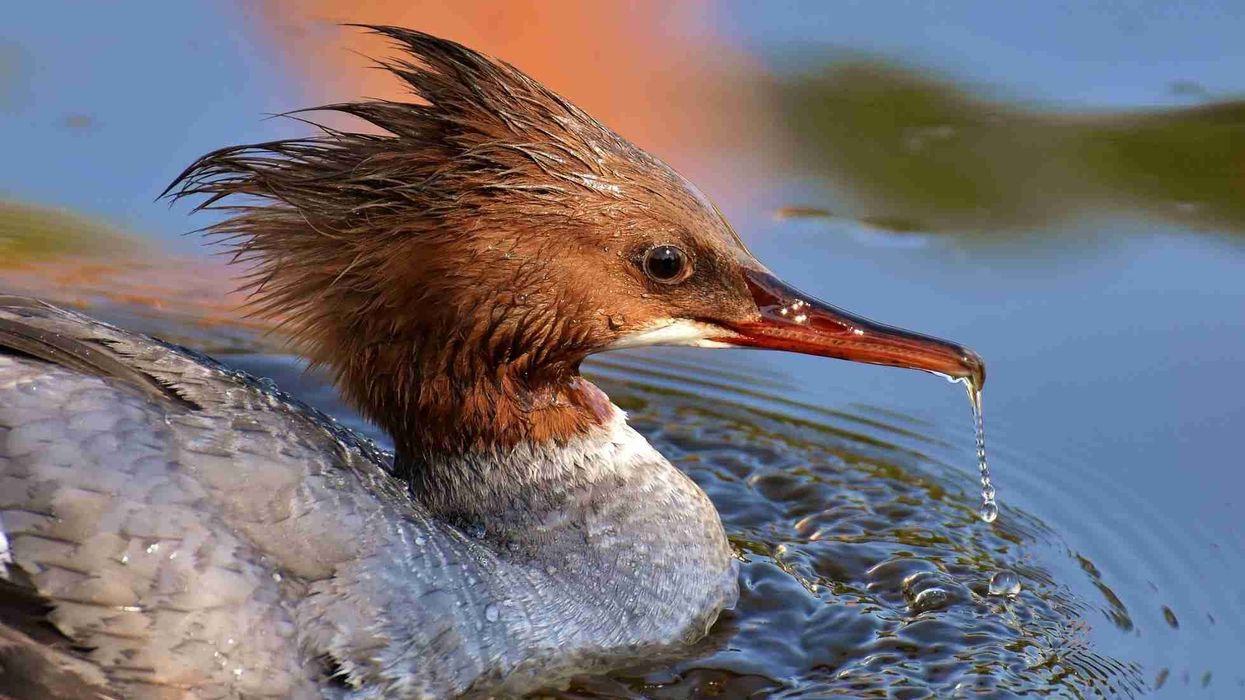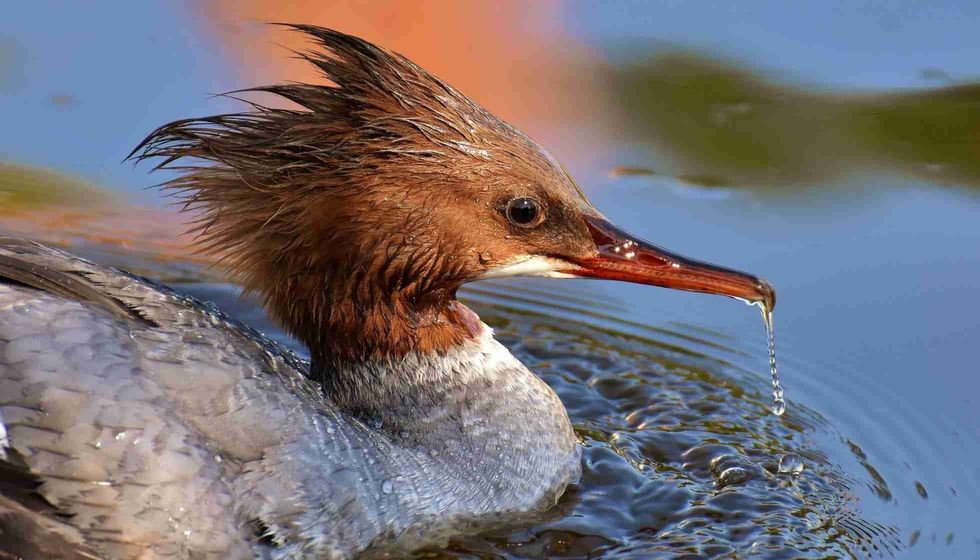Fun Merganser Facts For Kids

Content
- What type of animal is a merganser?
- What class of animal does a merganser belong to?
- How many mergansers are there in the world?
- Where does a merganser live?
- What is a merganser's habitat?
- Who do mergansers live with?
- How long does a merganser live?
- How do they reproduce?
- What is their conservation status?
- What do mergansers look like?
- How cute are they?
- How do they communicate?
- How big is a merganser?
- How fast can a merganser fly?
- How much does a merganser weigh?
- What are their male and female names of the species?
- What would you call a baby merganser?
- What do they eat?
- Are they friendly?
- Would they make a good pet?
- Did you know...
- How long can a merganser stay underwater?
- Can you eat mergansers?
Mergansers, also known as common mergansers or goosanders in Europe, Asia, and North America, are large aquatic sea ducks found in forested areas of Europe, Asia, and North America. Common mergansers are fish-eating birds that build their nest boxes in tree holes.
Carl Linnaeus, a Swedish naturalist, published the first systematic account of common mergansers in the tenth edition of his 'Systema Naturae' in 1758.
Mergus merganser is the current binomial name for this species. The genus name, merganser, is derived from 'mergus' and 'anser', Latin for 'goose', and was used by famous Roman writers like Pliny the Elder to refer to an unidentified waterbird.
In his book 'The Birds Of America', published in 1843, John James Audubon used the term 'buff-breasted merganser' in addition to 'goosander'. So, as you can see, this bird has had a lot of different names over the years!
The aquatic merganser measures 23–28 in (58–72 cm) in length, has a wingspan of 31–38 in (78–97 cm). It typically weighs 2–4.6 lb (0.9–2.1 kg) and males are marginally larger than females, although there is some variation.
It has a crest of long head feathers, like other Mergus species, but these are typically smooth and rounded behind the head, rather than forming an erect crest.
An adult males' plumage can be distinguished easily. The body is white with a variable salmon-pink tinge, the head is black with an iridescent green gloss, the rump and tail are grey, and the wings are mostly white on the inner half and black on the outer half of adult males with breeding plumage.
If you enjoy these facts about common mergansers, why not also take a look at these articles on the cockle or the African clawed frog.
Merganser Interesting Facts
What type of animal is a merganser?
Common merganser ducks are the largest freshwater duck in North America.
What class of animal does a merganser belong to?
Common mergansers are water birds belonging to the class of Aves and the order Anseriformes, family Anatidae.
How many mergansers are there in the world?
The merganser bird species comes in six different varieties, three of which are widely seen in North America. Common mergansers have a wide distribution in the northern hemisphere but their exact number around the world is not currently known. They are not rare to spot, but although they exist sparsely around oceans.
Where does a merganser live?
For all times of the year, they are mostly found in freshwater. In the summer they are found in forested countryside and on shallow yet clean rivers and lakes.
They tend to avoid deep marshes and murky waters. In the winter, they can be found on lakes and large rivers, as well as on coastal bays of the Pacific coast.
What is a merganser's habitat?
Common merganser ducks are diurnal birds that hunt in the early morning, late afternoon, and just before sunset.
When they aren't diving for small fish or their other aquatic prey, they can be seen swimming on the surface of the water or sitting on rocks in the middle of a river which is their common habitat.
They can even be found hiding among riverbank plants or (in the winter) on the edge of floating ice as lakes freeze.
Common mergansers float down their habitat of larger streams and rivers, lakes, and ponds for a few miles before flying back or, more generally, fishing their way back, diving incessantly the whole way.
Also known as goosanders, these birds can be found in both the Nearctic and Palearctic regions. Despite the fact that their numbers have been declining in North America, they are still the most common merganser there.
The common merganser range during their breeding season can be as far north as southern Alaska and Canada in North America.
In the northern and western United States, some of these birds stay all year round in the same habitat without migrating.
The North American birds spend winter in New England, the midwest, the south, and along the Pacific coasts of the United States and Canada. In the Palearctic zone, common mergansers usually breed in northern Europe, Scandinavia, Russia, and most of northern Asia.
Who do mergansers live with?
The common merganser species spends a lot of time afloat, lounging, fishing, and sleeping on the open sea, forming big or small groups. It is possible for them to form flocks of up to 75 individuals.
Common mergansers sometimes swim in small groups along the shoreline, diving with a slight jump after dipping their heads underwater to hunt for prey.
When one bird dives in front of a big party, the others always imitate the leader and vanish underwater too. They can remain underwater for up to two minutes, but most dives last for under 30 seconds.
The merganser bird species is usually vigilant, and one or two birds remain on duty to alert the flock of imminent threats at all times. When disturbed in their habitat, common mergansers tend to gorge themselves on food before fleeing.
Mergansers are clumsy on the ground, but occasionally they will run. They have a very upright posture, comparable to penguins, and will sometimes fall and slip.
How long does a merganser live?
The common merganser's lifespan ranges from 10-13 years.
How do they reproduce?
Mated pairs of common merganser males and females stay together for the whole breeding season, and sometimes for many breeding seasons after that. When a male common merganser circles a female in late winter, extending his neck forward and with his head feathers upright, this is considered to be a display of courtship.
Common merganser ducks' breeding season comes once every year and these birds prefer breeding in a tree cavity. Between May and June (their breeding season), the female lays between nine and 12 eggs.
The incubation period is 30-35 days long and the eggs are 2.52 in (64 mm) long. These eggs are light yellow, ivory, or white buff in color and the young birds accompany their mothers to feeding sites after hatching.
As soon as these common merganser chicks leave their nest boxes, they can learn to swim and feed quickly, but for the first few days, they eat predominantly from the water's surface.
The young birds are expert divers in just eight days and adult females leave the immature common merganser chicks just 30 to 50 days after hatching before they learn to fly. After being left, these young chicks follow other young birds, forming a group together.
What is their conservation status?
While the impact of the sport of fishing is a concern in some regions, this species' conservation status is Least Concern according to the IUCN. However, wetland degradation, pesticide, and lead pollution may pose a danger to these birds in the long run.
Merganser Fun Facts
What do mergansers look like?
These ducks have a red bill and a dark green body. Females have a gray body and the young birds have a white chest and rusty-cinnamon brown head. Males' non-breeding plumage looks very similar to the female plumage. The birds have large white spots on their upper wings and these are typically larger in adult males.
How cute are they?
Common mergansers are really cute birds with their clumsy walk and behaviors. Truly adorable!
How do they communicate?
When swimming in the sea, common mergansers use their excellent eyesight to locate prey underwater. When the water is murky, they will even hunt food by probing underwater crevices.
Males and females are mostly mute during courtship, but males make certain calls, including hoarse croaking noises and a twang that sounds like a guitar chord.
Females have a harsh 'karrrr-karr' call that can be heard during courtship or to alert others of a predator.
It has been recorded that two or more birds dive from flight into the water with a specific body position, making an audible hollow sound, but the intent of this action is unclear.
This flight into the water might or might not link to the breeding season of the bird, or this flight into the water by a common merganser duck might also be part of some sort of common merganser call during winter.
How big is a merganser?
These North American birds measure 23-28 in (58–72 cm) and the common merganser wing-span ranges from 31–38 in (78–97 cm).
How fast can a merganser fly?
When it comes to the speed of these merganser birds, they are among the fastest ducks in the world. However, in a common merganser vs red-breasted merganser comparison, the red-breasted merganser holds the fastest flying speed of 81 mph (130 kph).
The speed of the common merganser is not officially recorded, but we know that their speed is not too far behind.
How much does a merganser weigh?
The common merganser's weight ranges between 2-4.6 lb (0.9–2.1 kg).
What are their male and female names of the species?
Common merganser drake is the name given to the male of the species while a female common merganser is called a hen.
What would you call a baby merganser?
Young common mergansers can be called 'common merganser ducklings' or 'chicks'.
What do they eat?
These North American birds eat fish, mussels, shrimp, and salamanders. Adult males have been known to consume fish up to 1 ft (30.48 cm) long. Ducklings consume more marine insects when they are young and they start eating fish as they grow up.
Are they friendly?
These are not the most friendly species and can be aggressive.
Would they make a good pet?
The common merganser (Mergus merganser) species has not been domesticated in any way by humans. They are wild birds and would not be good pets.
Did you know...
One of the most interesting common mergansers facts is that these birds will capture fish by diving directly underwater and staying submerged for up to two minutes. This allows them to effectively capture fish and they resurface in order to swallow their prey, which they turn around and swallow headfirst.
This technique protects the merganser from being harmed by the spiny fins of any fish.
Because of their long guttural call, which can be heard a half-mile away, hooded mergansers are often referred to as 'frog ducks'.
Single females have been seen with over 70 ducklings at one time, suggesting that common mergansers form crèches. Merganser ducklings in the water can form a tight-knit community that resembles a swimming muskrat. Sharp-shinned hawks, for example, are often be tricked by this instinctive action.
The common merganser (Mergus merganser) is larger than the common goldeneye.
Juvenile common merganser birds look very similar to adult female mergansers in terms of appearance, whether they are male or female themselves.
How long can a merganser stay underwater?
Common merganser birds capture fish by diving directly under the water and can stay submerged for up to two minutes.
Can you eat mergansers?
Yes, but common mergansers eat fish, which imparts a heavy taste to their meat that many people dislike. Mergansers aren't the most appetizing food, which is why most people stay away from them.
Here at Kidadl, we have carefully created lots of interesting family-friendly animal facts for everyone to discover! Learn more about some other birds including the vulture, or the horned frog.
You can even occupy yourself at home by drawing one on our Common merganser coloring pages.
Scandinavia siberia North America
Get directionsWe Want Your Photos!
More for You
Sources
https://animalia.bio/common-merganser
https://animaldiversity.org/accounts/Mergus_merganser/
https://www.allaboutbirds.org/guide/Common_Merganser/maps-range
https://en.wikipedia.org/wiki/Common_merganser
See All
Bachelor of Commerce specializing in Accounting and Finance, Master of Business Administration

Divya RaghavBachelor of Commerce specializing in Accounting and Finance, Master of Business Administration
With a diverse range of experience in finance, administration, and operations, Divya is a diligent worker known for her attention to detail. Born and raised in Bangalore, she completed her Bachelor's in Commerce from Christ University and is now pursuing an MBA at Narsee Monjee Institute of Management Studies, Bangalore. Along with her professional pursuits, Divya has a passion for baking, dancing, and writing content. She is also an avid animal lover who dedicates her time to volunteering for animal welfare causes.
Bachelor of Arts specializing in English Literature

Deeti GuptaBachelor of Arts specializing in English Literature
A detail-oriented fact-checker with a research-oriented approach. Devika has a passion for creative writing, she has been published on multiple digital publishing platforms and editorials before joining the Kidadl team. Currently pursuing a Bachelor of Arts in English Literature from St.Xavier's College, Deeti has won several accolades and writing competitions throughout her academic career.
Disclaimer
1) Kidadl is independent and to make our service free to you the reader we are supported by advertising. We hope you love our recommendations for products and services! What we suggest is selected independently by the Kidadl team. If you purchase using the Buy Now button we may earn a small commission. This does not influence our choices. Prices are correct and items are available at the time the article was published but we cannot guarantee that on the time of reading. Please note that Kidadl is a participant in the Amazon Services LLC Associates Program, an affiliate advertising program designed to provide a means for sites to earn advertising fees by advertising and linking to Amazon. We also link to other websites, but are not responsible for their content.
2) At Kidadl, we strive to recommend the very best activities and events. We will always aim to give you accurate information at the date of publication - however, information does change, so it’s important you do your own research, double-check and make the decision that is right for your family. We recognise that not all activities and ideas are appropriate for all children and families or in all circumstances. Our recommended activities are based on age but these are a guide. We recommend that these ideas are used as inspiration, that ideas are undertaken with appropriate adult supervision, and that each adult uses their own discretion and knowledge of their children to consider the safety and suitability. Kidadl cannot accept liability for the execution of these ideas, and parental supervision is advised at all times, as safety is paramount. Anyone using the information provided by Kidadl does so at their own risk and we can not accept liability if things go wrong.
3) Because we are an educational resource, we have quotes and facts about a range of historical and modern figures. We do not endorse the actions of or rhetoric of all the people included in these collections, but we think they are important for growing minds to learn about under the guidance of parents or guardians.







